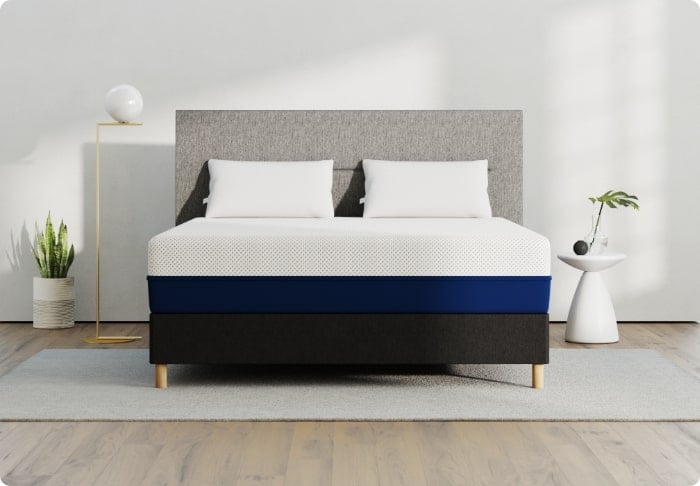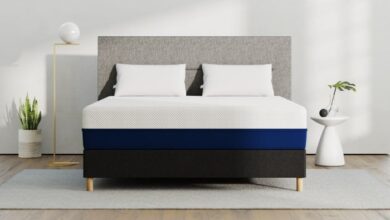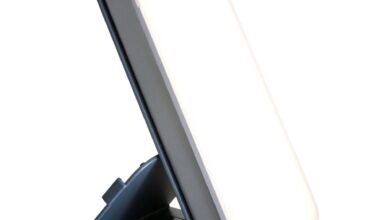Is it Safe to Sleep with a Hat On? Benefits, Risks & Best Types (2025)

Quick answer: Sleeping with a hat is safe for most adults and offers benefits like reduced hair breakage, style preservation, and warmth. Choose loose-fitting satin or silk caps to avoid traction damage. Never use hats on infants due to suffocation risk. Wash your sleep hat weekly to prevent bacteria buildup.
Key Takeaways
- Safety first: Safe for adults, but never use on infants or small children due to suffocation and overheating risks
- Best materials: Satin, silk, or bamboo reduce friction. Avoid tight cotton that dries hair
- Hair benefits: Reduces breakage for curly/textured hair and preserves overnight styling
- Proper fit: Choose loose-fitting caps that don’t leave marks or cause headaches
- Hygiene: Wash weekly (more often for oily hair) to prevent bacteria and scalp irritation
- Quick links: Best pillows for side sleepers. Mattress guide for neck pain.
Have you ever wondered if wearing a hat to bed helps or hurts your sleep? Many people ask this question during cold winter nights or when trying to protect a special hairstyle. Sleeping with a hat is generally okay and offers several benefits for both comfort and hair health.
People have used nightcaps and sleep bonnets for centuries, showing this practice has stood the test of time. While hats can keep you warm and protect your hair, you should know about some safety concerns before starting this nighttime habit.
The right sleep hat can become a valuable part of your bedtime routine, but the wrong one might cause problems. Understanding when and how to wear a hat to bed will help you decide if this practice is right for you.
Keep reading to discover if a sleep hat might be the solution to your nighttime hair troubles and how to choose the perfect one for your needs.
What Are the Benefits of Wearing a Hat While Sleeping?
- Sleep hats trap body heat for warmth, reduce friction that causes hair damage, and help preserve hairstyles overnight.
Humans have worn various head coverings to sleep for centuries. From nightcaps in Victorian times to modern sleep bonnets, people have found reasons to cover their heads at night.
Covering your head at night offers multiple advantages that can improve both your sleep quality and hair health. These benefits range from keeping you warm to saving you time on your morning hair routine.
Temperature regulation and warmth
Your head releases a lot of body heat. Wearing a hat while you sleep helps trap this warmth, making you feel cozy on cold nights. This benefit proves especially helpful if you:
- Live in a cold climate
- Keep your bedroom cool at night
- Often wake up feeling chilly
Your body needs to maintain a steady temperature for good sleep. A hat works as an extra layer of insulation that helps your body use less energy to stay warm.
Hair protection and maintenance
Your hair faces a surprising amount of damage while you sleep. As you move during the night, your hair rubs against your pillow, causing friction. This friction leads to:
- Split ends
- Breakage
- Frizz
- Tangling
A sleep cap or hat reduces this friction dramatically. The smooth material allows your hair to glide instead of catch, keeping it healthier and more hydrated. Many people with dry or damaged hair see a big improvement when they start wearing a hat to bed.
It can also ensure, if you’re sleeping with overnight rollers or leave-in products, that they don’t shift out of your hair as you sleep.
And in some cases, it can protect your pillow and mattress, such as when you have freshly colored hair and want to prevent hair dye stains on your bedding.
Style preservation
Spent an hour styling your hair? A sleep hat helps preserve that hard work. By keeping your hairstyle contained, you prevent it from getting crushed or misshapen overnight. This benefit saves you time in the morning since you won’t need to completely restyle your hair.
Many people with curly, wavy, or textured hair find that sleeping in a satin or silk cap helps maintain their curl pattern. The smooth fabric prevents frizz and helps styles last for days instead of hours.
What Are the Risks to Consider with Sleeping in a Hat?
- Tight hats can cause hair loss, poor material choices may disrupt sleep, and unwashed hats harbor bacteria that harm scalp health.
Before you grab any hat for bedtime, you should understand the possible drawbacks that might affect your hair health and sleep quality. Being aware of these risks helps you make smart choices about sleeping with headwear.
Hair Health Concerns
The wrong type of sleep hat can damage your hair instead of protecting it, especially if it fits too tightly on your head.
- Traction danger: Very tight hats pull on your hair follicles and can lead to traction alopecia, a type of hair loss caused by constant pulling.
- Root damage: When hair roots experience ongoing stress from tight headwear, they weaken and may stop producing new hair.
- Comfort test: Your sleep hat should feel loose enough that it doesn’t create pressure on your scalp or leave marks when removed.
If you wake up with a headache or feel immediate relief when taking off your sleep hat, take this as a warning sign that your hat is too tight and could harm your hair over time.
Sleep Quality Factors
Wearing a hat to bed affects different people in different ways, potentially changing how well you sleep through the night.
- New sensation: People who aren’t used to sleeping with headwear might feel distracted or uncomfortable until they adjust to the feeling.
- Temperature balance: While hats help in cold rooms, they can cause overheating in warm environments, disrupting your sleep cycle.
- Comfort priority: The wrong material or fit might make you more aware of the hat than your sleep, defeating the purpose of wearing it.
Your body needs the right temperature to sleep well, so pay attention to how your sleep hat affects your comfort throughout different seasons and room conditions.
Hygiene Importance
A sleep hat collects oils, dead skin cells, and product residue each night, making regular cleaning essential for hair and scalp health.
- Bacteria trap: Unwashed sleep hats create the perfect environment for bacteria growth, which can lead to scalp problems and breakouts.
- Weekly washing: Clean your sleep hat at least once a week, or more often if you have oily hair, sweat at night, or use many hair products such as dye and hair oils.
- Health protection: Using a dirty sleep hat works against your hair health goals and might cause irritation or acne along your hairline.
The benefits of wearing a sleep hat quickly disappear if you don’t maintain proper hygiene, turning a helpful habit into a potential source of skin and hair problems. And no one wants to have to sleep with a rash or acne because of a dirty hat.
Who Should or Should Not Wear a Sleep Hat?
- Infants should never wear sleep hats due to suffocation risk, while people with curly or textured hair see the greatest benefits from satin or silk caps.
Sleep hats affect various groups differently, with important safety concerns for some and extra benefits for others. Understanding these special considerations helps you make appropriate choices based on your specific situation or hair type.
Safety warnings for infants and small children
Never put a hat on an infant or small child while they sleep. Babies cannot adjust their head coverings if they slip, creating a serious suffocation risk.
The hat might also cause dangerous overheating, which links to
Sudden Infant Death Syndrome
(
SIDS
). Always follow safe sleep
guidelines
for infants, which recommend no loose items in the crib for a
safe sleep space.
Safe alternatives to keep babies warm:
- Maintain room temperature between 68-72°F
- Use sleep sacks rated for current room temperature
- Dress baby in fitted, one-piece pajamas
- Never place loose items (blankets, pillows, hats, toys) in crib
When babies can wear hats: Only during supervised awake time. Remove before any sleep (naps or nighttime).
Benefits for people with certain hair types
People with curly, coily, or textured hair often see the greatest benefits from sleeping in a bonnet or hat. These hair types tend to:
- Lose moisture easily
- Break more readily with friction
- Require more styling time
A satin or silk sleep cap reduces breakage for many people with these hair types. The smooth fabric helps maintain moisture and prevents the crushing of carefully styled curls.
People sleeping with long hair also benefit from sleep hats, as longer strands tangle more easily during sleep.
Considerations for people with certain health conditions
If you’re experiencing hair loss from medical treatments or conditions, a soft sleep hat provides both physical and emotional comfort. It helps protect delicate new growth and maintains body heat when you have less hair.
People with sensitive scalps should choose very soft, non-irritating materials. Cotton can pull moisture from your hair and skin, so silk, satin, or bamboo materials work better for sensitive skin.
How Do You Choose the Right Sleep Hat?
- Look for loose-fitting satin or silk materials that reduce friction, adjust fabric weight by season, and prioritize designs that stay in place without pressure.
Finding the perfect sleep hat involves considering the material, design, and your changing needs throughout the year. The right choice makes all the difference between a comfortable night that protects your hair and one that leaves you frustrated.
Which materials work best for sleep hats?
| Material | Best For | Pros | Cons |
|---|---|---|---|
| Silk | Curly/textured hair | Ultra-smooth, hypoallergenic, moisture-retention | Expensive, delicate care |
| Satin (polyester) | Budget-conscious | Smooth, affordable, easy care | Less breathable than silk |
| Bamboo | Sensitive scalps | Breathable, moisture-wicking, eco-friendly | Can be less smooth |
| Cotton | Not recommended | Affordable, widely available | Absorbs moisture, causes friction |
The fabric of your sleep hat directly affects how well it protects your hair and how comfortable you feel wearing it all night.
- Smooth surfaces: Silk and satin provide the most hair-friendly surfaces, reducing friction that causes breakage and frizz.
- Temperature control: Breathable fabrics like bamboo prevent overheating while still offering protection for your hair and style.
- Sweat management: Moisture-wicking materials keep your scalp dry and comfortable if you tend to perspire during sleep.
Avoid regular cotton hats for sleeping, as they actually pull moisture from your hair and increase dryness and frizz instead of protecting against these problems.
What design features should you look for in a sleep hat?
The structure of your sleep hat determines whether it stays in place comfortably without causing damage to your hair.
- Secure closures: Look for adjustable drawstrings or closures that keep the hat in position without creating pressure points.
- Gentle bands: Choose hats with stretchy but not tight elastic bands that hold without pulling on delicate hair edges.
- Proper sizing: Ensure your hat provides enough room for your specific hair type, length, and volume.
Specialized sleep caps like satin bonnets or “slap caps” work much better than regular daytime hats because their designs address the specific challenges of nighttime wear.
Should you change your sleep hat by season?
Your sleep hat needs change with seasons, hairstyles, and even your nightly comfort preferences.
- Weather adaptations: Select thinner caps during warm weather and thicker, more insulating options to stay warm in bed during cold winter months.
- Style accommodation: Choose larger bonnets when wearing protective styles like braids or twists that need extra space.
- Comfort listening: Pay attention to your body’s signals about what feels right—some nights you might skip the hat entirely.
The best sleep hat strategy involves owning a few different options that you can rotate based on your changing needs, rather than trying to make one type work for every situation.
How do you start using a sleep hat safely?
Starting a sleep hat routine takes a few simple steps to ensure comfort and results:
Week 1: Adjustment period
- Expect 3-5 nights to adjust to the sensation
- If uncomfortable, try for 2-3 hours before bed first
- Ensure hat isn’t too tight (should remove easily without marks)
Set yourself up for success:
- Buy two hats: Rotate while washing
- Establish a routine: Put hat on during your regular bedtime routine
- Start seasonal: Begin in winter when warmth benefits are obvious
- Choose quality: Invest in $20-40 range for better materials
Monitor your results:
- Check for scalp irritation or pressure marks
- Assess whether hat stays on through the night
- Evaluate hair condition after 2-3 weeks (less breakage, better moisture)
- Adjust size or material if issues persist
Next Steps with Your Sleep Hat Action Plan
Ready to try sleeping with a hat? Follow these steps for the best experience:
Evaluate if a sleep hat is right for you
- Consider your hair type and common problems (dryness, breakage, style preservation)
- Think about your sleeping environment (temperature, humidity)
- Identify any scalp sensitivity issues, such as dry scalp
Find the perfect sleep hat
- Research materials that match your needs (silk, satin, bamboo)
- Look for proper fit (loose enough not to cause pressure)
- Consider investing in a quality product rather than the cheapest option
Establish a healthy sleep hat routine
- Create a hat washing schedule (at least weekly)
- Keep a spare hat for rotation while washing
- Develop a pre-sleep routine that includes putting on your hat
Monitor for any problems
- Watch for any signs of scalp irritation or discomfort
- Check if your hat stays in place through the night
- Assess whether your hair shows improvement after a few weeks of use
By following these steps, you’ll discover if sleeping with a hat improves your hair health and sleep quality. For most people, the right sleep hat becomes a simple but effective part of their nighttime routine that leads to better hair days and comfortable sleep.
FAQs
Is it safe to wear a hat to bed every night?
Yes, wearing a properly fitted, clean sleep hat every night is safe for most adults and can actually improve hair health over time.
Will sleeping with a hat make me too hot?
Your sleep hat material matters—choose breathable fabrics like bamboo or lightweight satin in warmer weather to prevent overheating.
Can wearing a hat while sleeping cause hair loss?
Only tight hats that pull on your hair follicles can cause hair loss (traction alopecia), so always choose loose-fitting sleep caps.
How often should I wash my sleep hat?
Wash your sleep hat at least once a week, or more often if you have oily hair or sweat during sleep.
Which sleep hat material works best for curly hair?
Silk or satin sleep caps work best for curly hair because they reduce friction that causes frizz and breakage.
Can I use my regular beanie as a sleep hat?
No, regular beanies often use cotton that dries hair, fit too tightly, and have thick seams that cause discomfort during sleep.
Should children wear sleep hats like adults do?
Never for infants or toddlers under 2 years; older children (3+) can safely wear appropriate sleep caps with supervision.
How long does it take to see results from using a sleep hat?
Most people notice reduced frizz and tangles within 1 week; breakage reduction and moisture improvement become visible after 3-4 weeks of consistent use.
Can you sleep with a cap on wet hair?
No, sleeping with wet hair is not recommended. It’s more prone to breakage and fungal growth, and trapping moisture under a cap worsens these problems. Always dry your hair thoroughly before wearing a sleep hat.
Can I wear a sleep hat with leave-in products?
Yes. The cap actually helps seal in moisture and prevents product transfer to your pillowcase. You might want to wear a cap after dying your hair to prevent mess on your pillow and bed.
Can I wear a sleep hat with hair curlers or rollers?
Yes, but you need a larger bonnet-style cap with extra room. Standard tight caps won’t accommodate rollers and will cause discomfort.
Can sleeping with a hat help if I have lice?
No, a sleep hat won’t treat or prevent lice, which require specific medicated treatments. However, wearing a hat during treatment can help contain loose lice and nits to make cleanup easier and reduce spread to bedding.
Conclusion
Sleeping with a hat offers clear benefits for hair health and comfort when you choose the right type for your needs. Consider a sleep hat if you:
- Have curly, coily, or textured hair prone to breakage
- Want to preserve overnight styling and save morning time
- Experience cold during sleep or keep your bedroom cool
- Have long hair that tangles easily
Skip sleep hats if you:
- Tend to overheat at night (unless using lightweight materials)
- Have an infant or very young child (safety risk)
- Find any head covering uncomfortable (try adjustment period first)
Your decision checklist:
- Choose silk or satin for maximum hair protection
- Ensure loose fit—no pressure marks or headaches
- Wash weekly minimum to prevent bacteria growth
- Give yourself 1 week to adjust to the sensation
- Assess hair improvement after 3-4 weeks consistent use
With the right material, design, and care routine, a sleep hat can become a valuable part of your nighttime self-care that leads to better mornings with healthier hair.




